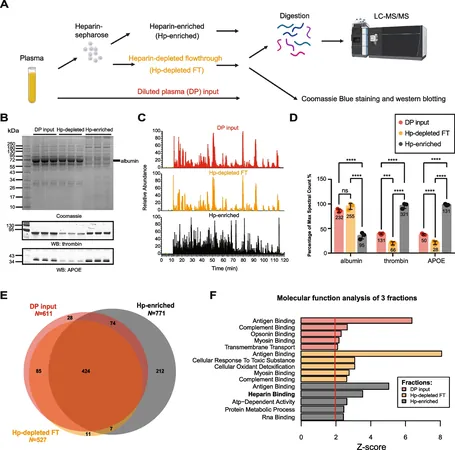
Groundbreaking Study Reveals Major Changes in Heparin-Enriched Plasma Proteome Linked to Alzheimer's Disease
2024-10-08
Author: Amelia
Research Overview
Using cutting-edge techniques, the study involved a rigorous analysis of plasma samples from 18 cognitively assessed individuals diagnosed with AD, alongside 18 healthy controls, all of whom provided informed consent. Researchers employed tandem mass tag (TMT) mass spectrometry to probe and quantify plasma proteins after enriching them through heparin affinity chromatography. This method proved effective in isolating heparin-binding proteins (HBPs), including key players like APOE and thrombin, known for their associations with neurodegenerative processes.
Scientific Findings
A staggering total of 3284 proteins were identified through the study, revealing 579 proteins that exhibited a significant increase and 661 that decreased in abundance among AD patients compared to healthy controls. Notably, among the elevated proteins were vital members of the matrix, which are involved in cellular signaling and structural integrity. Importantly, proteins such as SMOC1, GPNMB, and PLA2G7 emerged with heightened levels, suggesting their roles in the pathology of AD. Furthermore, the research highlighted that the heparin-enriched plasma proteome identified approximately 771 proteins that were unique compared to traditional immunodepletion methods, showcasing the strength and breadth of the heparin enrichment approach.
Implications for Alzheimer's Disease Diagnosis
These findings spark excitement around the potential for developing blood-based biomarkers for early diagnosis of Alzheimer’s. The notable correlation between plasma changes and established cerebrospinal fluid (CSF) biomarkers supports the hypothesis that peripheral blood analysis can provide insights reflective of neurodegenerative changes happening in the brain. Identification of APOE variants, particularly APOE4—which is notorious for its association with increased risk of AD—was emphasized. The research uncovered a significant degree of interaction between the APOE isoforms and heparin, reflecting a deeper biological connection that's critical for understanding genetic susceptibilities to AD.
Future Directions and Broader Impact
As the research community becomes increasingly aware of the systemic implications of neurodegenerative diseases, this breakthrough in understanding the plasma proteome paves the way for future studies to explore how Alzheimer's may not only be a brain disorder but one that involves peripheral interactions affecting overall health. The rich data gathered provides fertile ground for investigating additional correlations between plasma proteins, cognitive function, and neurodegeneration. Moreover, as these research techniques are refined and applied to broader, more diverse populations, including various racial and ethnic groups, a more comprehensive view of AD can emerge, potentially identifying novel biomarkers that assist in diagnosis and therapeutic strategies. In summary, this study represents a giant leap forward in Alzheimer’s research, showcasing how plasma proteomics can illuminate the complex interplay of biological factors contributing to AD, with the potential to transform diagnosis and treatment strategies in the future.









 Brasil (PT)
Brasil (PT)
 Canada (EN)
Canada (EN)
 Chile (ES)
Chile (ES)
 España (ES)
España (ES)
 France (FR)
France (FR)
 Hong Kong (EN)
Hong Kong (EN)
 Italia (IT)
Italia (IT)
 日本 (JA)
日本 (JA)
 Magyarország (HU)
Magyarország (HU)
 Norge (NO)
Norge (NO)
 Polska (PL)
Polska (PL)
 Schweiz (DE)
Schweiz (DE)
 Singapore (EN)
Singapore (EN)
 Sverige (SV)
Sverige (SV)
 Suomi (FI)
Suomi (FI)
 Türkiye (TR)
Türkiye (TR)